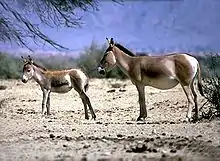hemione
See also: hémione
English

Equus hemionus
Alternative forms
Etymology
From New Latin hēmionus, from Ancient Greek ἡμῐ́ονος (hēmíonos, “half ass, mule”).
Pronunciation
- IPA(key): /ˈhɛmiəʊn/
Noun
hemione (plural hemiones)
- Equus hemionus, the onager or kiang, a kind of wild ass of Tibet.
- 1890 September, Edouard L. Troussart, “Wild Horses”, in Popular Science, page 627:
- Its head is large, with ears smaller than those of the hemione, the shoulders thick, especially in the male, the limbs robust and stubbier than those of the hemiones and the asses.
- 1985, Augusto Azzaroli, An Early History of Horsemanship, page 24:
- They presumably belong to hemiones (hemiones were actually recorded from the same level at Rana Gundhai) and, in spite of some optimistic statements to the contrary, it is sometimes impossible to distinguish horses fom hemiones on isolated teeth alone.
- 2000, C. P. Groves, O. A. Ryder, “Systematics and Phylogeny of the Horse”, in Ann T. Bowling, Anatoly Ruvinsky, editors, The Genetics of the Horse, page 11:
- Another possible area of disagreement is that asses and hemiones are associated unequivocally in the morphological tree, but less definitely in the genetic tree: whether hemiones and African ('true') wild asses are more closely related to horses or whether they are most closely related to each other and form a separate lineage has yet to be resolved unequivocally by the DNA data, and note that in the morphological data they are united by only a single derived condition (Fig. 1.1).
This article is issued from Wiktionary. The text is licensed under Creative Commons - Attribution - Sharealike. Additional terms may apply for the media files.